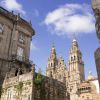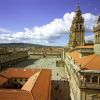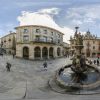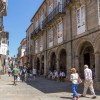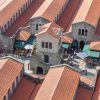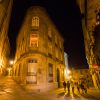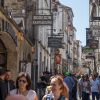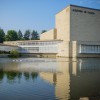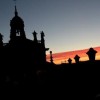- Accede I
- Regístrate I
- carrito
Catedral de Santiago
La catedral románica de Santiago de Compostela es el cuarto edificio que se levanta sobre el mausoleo del apóstol Santiago. Tras el descubrimiento en el siglo IX de sus reliquias, se construyeron una primera capilla y luego una iglesia prerrománica que fue destruida en 997 por la invasión musulmana comandada por Almanzor. En el siglo XI ya existía una nueva basílica, pero en el año 1075 se decidió levantar una catedral capaz de albergar a los miles de peregrinos. Es la catedral actual, cuyo lado oeste fue rematado con la realización de la obra cumbre de la escultura románica: el Pórtico de la Gloria.
Pórtico de la Gloria
Concebido como atrio o nártex de la catedral, el conjunto esculpido por el Maestro Mateo entre 1168 y 1188 consta de tres arcos y más de 200 figuras de granito que componen un mensaje teológico centrado en la idea de la salvación. En el arco central reina la visión apocalíptica de la Jerusalén Celeste : Cristo resucitado, rodeado por los cuatro Evangelistas, y sobre ellos, en la arquivolta, los 24 ancianos que afinan los instrumentos para entonar el canto de la Gloria.
El arco lateral izquierdo se destina a escenas del Antiguo Testamento, y se apoya sobre columnas que muestran a los profetas. Entre ellos sobresale Daniel, cuya expresiva sonrisa anuncia los primeros pasos del gótico en Compostela, patentes también en la bóveda de crucería. La sabiduría popular, sin embargo, sostiene que el profeta Daniel sonríe ante la belleza de la reina Esther, la sonrojada figura femenina que tiene enfrente.
El arco derecho, por su parte, se dedica al Juicio Final, y se apoya sobre figuras de apóstoles: Pedro, Pablo, Santiago y Juan. Como patrón de la Catedral , Santiago vuelve a aparecer en la columna central de mármol, labrada con una representación del Árbol de Jesé o genealogía de Cristo, que muestra a media altura las profundas huellas de las manos peregrinas. Detrás de la columna, el Maestro Mateo arrodillado era conocido como el ‘Santo de los Croques', pues la tradición popular le atribuía el poder de transmitir su talento a quienes le diesen tres ‘croques' o cabezazos.
Naves, Altar Mayor y capillas
La Catedral conserva su estilo románico original en la planta de cruz latina típica de las iglesias de peregrinación, con tres naves en el sentido longitudinal y tres en el crucero, coronadas por un triforio que rodea todo el templo. Esta galería resultaba un elemento útil en la Edad Media , cuando muchos peregrinos se veían obligados a pernoctar en la Catedral a la espera del primer oficio religioso. Además, imprime elegancia el espacio interior, al elevarlo hasta los 24 metros .
A la nave mayor se abren cuatro de las 16 capillas de la Catedral , que se vuelven 18 si se cuentan la de la cripta y el claustro. A la izquierda están la capilla de la Comunión , de estilo neoclásico, y la del Santo Cristo de Burgos; las de la derecha albergan las colecciones de reliquias, el panteón real y el tesoro del museo catedralicio.
El Altar Mayor da muestra de la fastuosa intervención de la arquitectura barroca en el espacio románico. El baldaquino de columnas salomónicas, que protege el altar de plata y el camarín del Apóstol, data del siglo XVII. Domingo Andrade completó el conjunto de maderas doradas, mármoles, jaspes y plata, desmesurados ángeles y un esplendor que se extiende hasta los órganos en los primeros tramos de la nave central, decorados por Miguel de Romay. En medio de la profusa ornamentación tienen lugar los ritos que justifican los esfuerzos de los caminantes: la Misa del Peregrino, que se celebra todos los días a las 12; el abrazo a la figura del Apóstol del siglo XIII que preside el altar; y, finalmente, la visita de las reliquias del Apóstol en su mausoleo subterráneo. Esta cripta alberga los restos mortales del siglo I, descubiertos según la tradición en el siglo IX, y que reposan en una urna del siglo XIX.
El Botafumeiro
A ambos lados del Altar Mayor se extienden los 65 metros del crucero, que es recorrido en fiestas solemnes por el Botafumeiro. Este enorme incensario comenzó por ser –probabelmente en el siglo XIII- instrumento de purificación del ambiente de la Catedral, en la que se apiñaban multitud de peregrinos. Hoy, incorporado a la liturgia, muestra su metro y medio de altura y sus 53 quilos de peso cuando, accionado por ocho ‘tiraboleiros’, comienza a 'volar' por el transepto. Basta minuto y medio para que alcance una velocidad de 68 kilómetros por hora y forme un ángulo de 82 grados sobre la vertical, lo que lo acerca hasta un escaso metro de la bóveda.
El recorrido por los brazos del crucero y la girola permite admirar arquitecturas y piezas artísticas de diferentes épocas. Un ejemplo es el desbordante barroco de la capilla del Pilar, en el extremo derecho del deambulatorio, decorada con motivos relativos a la peregrinación, como las conchas y la cruz de Santiago. Cerca se halla la Puerta Santa , que se abre exclusivamente en los Años Jubilares. Le sigue la capilla central de la girola, llamada del Salvador, punto de arranque de la construcción románica en el año 1075.
La salida por el brazo norte del crucero permite dar un vistazo a la capilla de la Corticela, un antiguo oratorio benedictino del siglo IX (reformado en el siglo XIII) unido al brazo norte del crucero, que conserva su carácter de parroquia independiente de la Catedral.









